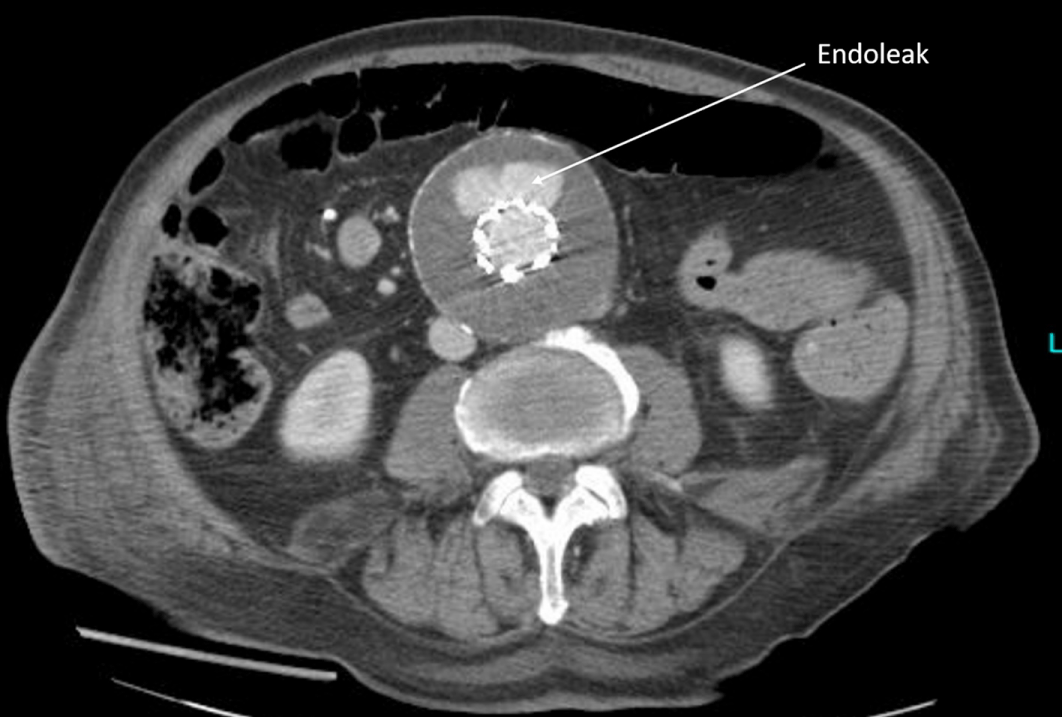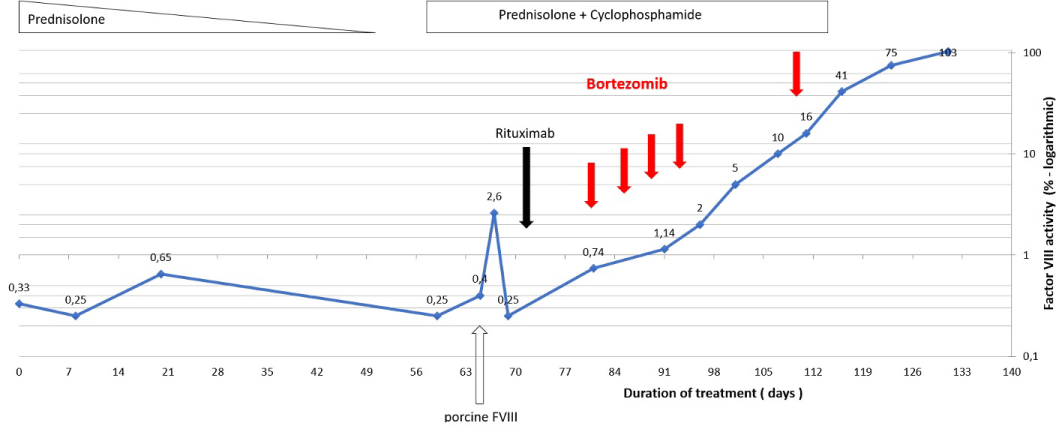
Case Report
Ann Hematol Oncol. 2018; 5(2): 1195.
Successful Bortezomib Salvage Therapy for Acquired Hemophilia
Schmälter AK¹*, Zimmermann C² and Rank A¹
¹Department of Hematology and Oncology, Klinikum Augsburg, Germany
²Department of Trauma, Plastic and Hand Surgery, Klinikum Augsburg, Germany
*Corresponding author: Schmälter AK, Department of Hematology and Oncology, Klinikum Augsburg, Stenglinstraße 2, 86156 Augsburg, Germany
Received: March 15, 2018; Accepted: April 17, 2018; Published: May 04, 2018
Abstract
This case report is about a patient with acquired hemophilia in which standard therapy with corticosteroids, cyclophosphamide and rituximab failed in an active bleeding incident. In our patient the coagulation factor VIII activity was below the detection limit of 0.25%, the autoantibody inhibitor titer was increased to 63 Bethesda units. An initial substitution with recombinant porcine factor VIII increased factor VIII activity insignificantly. A long-term application of activated recombinant human factor VII was necessary to control the bleeding situation. No cause could be found for the acquired hemophilia. Finally, a salvage therapy with the proteasome inhibitor bortezomib resulted in a continuous increase in factor VIII activity. In theory the effectiveness is due to the elimination of CD20 negative plasma cells which produce the autoantibodies against coagulation factor VIII.
Keywords: Hemophilia, Coagulation factor VIII, Bortezomib
Introduction
Acquired hemophilia has an incidence rate of 1 person/1000000/ year and is therefore a rare autoimmune disease associated with the occurrence of life-threatening bleeding [1]. In this hemorrhagic diathesis autoantibodies of the IgG class are secreted by plasma cells and are directed against coagulation factor VIII. Acquired hemophilia occurs mainly in patients over 50 years of age and is idiopathic in 50% of cases. Causes may include pregnancy, underlying autoimmune diseases such as systemic lupus erythematosus or malignant neoplasms [2]. Subcutaneous hemorrhage is most common, followed by muscle and gastrointestinal bleeding, which may also occur simultaneously [3].
Basic principles of treatment are firstly the control of acute bleeding, secondly the elimination of the inhibitor to restore normal hemostasis and, thirdly, the treatment of existing causes. For acute hemostasis, replacement therapy with recombinant porcine factor VIII can be attempted. Alternatively, recombinant activated factor VII (raFVII) or prothrombin complex concentrate can be administered. The first-line therapy for eliminating the inhibitor is immunosuppression with corticosteroids. If this is not effective, the therapy can be supplemented with cyclophosphamide or rituximab [4]. To monitor the response to therapy, factor VIII activity is used.
Patient information and diagnostics
A 77-year-old Caucasian patient was admitted to trauma surgery for treatment of wound healing disorders following rotator cuff reconstruction. Peri-and postoperatively bleeding complications occurred. The cause of the new bleeding tendency was acquired hemophilia, the factor VIII level was less than 0.25% (reference values 70-150%). The patient received a transient substitution with raFVII and prednisolone, which led to a slight increase in factor VIII activity.
The patient has been wheelchair-bound for more than 50 years due to a spastic paresis of both legs. Otherwise, type 2 diabetes mellitus, arterial hypertension and moderate aortic stenosis are known.
Two months later, the patient was admitted to vascular surgery for an urgent revision of a Type III endoleak after implantation of an aorto-biiliac stent graft in an abdominal aortic aneurysm five years ago (Figure 1). However, prior to the planned surgery, a prolonged PTT to 123 s (reference 26-36 s) and large hematomas on the right lateral thoracic wall had been noted. After reduction of the immunosuppression the factor VIII activity was again below the detection limit of 0.25%, so the revision of the endoleak was not feasible. The Bethesda essay for determining the inhibitor titer showed an increase to 63 Bethesda units (reference values 0-0.5). Imaging, laboratory and clinical diagnostics revealed no evidence of neoplasia, other underlying autoimmune diseases or an infectious cause of the acquired hemophilia.

Figure 1: Abdominal computer tomography with illustration of the endoleak.
Therapy and progress
The patient again received immunosuppressive therapy with prednisolone to eliminate the inhibitor. The immunosuppression initially led to an improvement of the plasmatic coagulation with slightly increasing factor VIII activity. In the context of dose reduction of the steroid treatment the factor VIII - levels fell again below the detection limit. Substitution with a total of 30,000 IU of recombinant porcine factor VIII over three days showed an inadequate increase in factor VIII levels to 2.6%, presumably due to a cross-reaction of the circulating inhibitors.
Following failure of monotherapy with prednisolone, guidelineappropriate [4] immunosuppression was supplemented by a weekly administration of cyclophosphamide 500 mg absolute. To this escalation of therapy the acquired hemophilia was again refractory. In the course a lower gastrointestinal bleeding occurred. The cause was a rectal hemorrhage due to second-degree circular hemorrhoids. The patient received 5 mg raFVII intravenously in the acute situation, subsequently the bleeding was stopped surgically. At high therapy pressure, 1 g of rituximab was additionally administered for further immunosuppression. For infection prophylaxis the patient received acyclovir and co-trimoxazole. Substitution with 5 mg raFVII every eight hours was continued. Ten days after surgical treatment of the hemorrhoid hemorrhage and attempted dose reduction of raFVII, secondary arterial bleeding occurred. It could be stopped surgically by increasing the dose of raFVII to every six hours.
With still undetectable factor VIII activity, we decided to initiate a salvage therapy with the proteasome inhibitor bortezomib analogous to the VCD protocol (bortezomib 1.3 mg/m2 on days 1, 4, 8 and 11, cyclophosphamide 500 mg absolute on day 1 and dexamethasone 20 mg absolute on days 1, 2, 4, 5, 8, 9, 11 and 12). Meanwhile, the dose of prednisolone was slowly reduced. Ten days after onset of bortezomib, there was a distinct increase in factor VIII activity (Figure 2). During the course of therapy the repeating doses of 5 mg raFVII were reduced and discontinued at a factor VIII activity level of 4% which was achieved 18 days after the start of the first VCD cycle. A second cycle of VCD with 900 mg/m2 cyclophosphamide on day 1, bortezomib 1.3 mg/m2 on day 1 and dexamethasone 20 mg on days 1 and 2 was started. As the factor VIII level continued to rise to 16%, an inhibitor titer of 2 Bethesda units and a PTT of 62 s was reached and no further bleeding events occurred, the patient was discharged.

Figure 2: Graphical Illustration of coagulation factor VIII–activity in percent (blue curve) over time in days.
The applications of porcine factor VIII (white), rituximab (black) and bortezomib (red are marked with arrows).
Outcome
Two weeks after discharge, the patient was again admitted to the hospital for revision of the endoleak (Figure 1). The endoleak was supplied endovascularly by the implantation of stent graft prosthesis. Postoperatively, wound healing was timely and control CT angiography showed a successfully switched off endoleak. Factor VIII activity was with 109% in the normal range during the stay. In the aftercare up to half a year after the onset of the remission, factor VIII activity was normal, the PTT has in the meantime completely normalized and no more bleeding events have occurred, so no further therapy cycles with VCD were necessary. The time between the onset of bortezomib and the attainment of a normal factor VIII level was approximately four weeks, with PTT normalizing approximately eight weeks after initiation of therapy.
Discussion
Our patient had received corticosteroids, cyclophosphamide and rituximab according to guidelines, after which no remission had occurred. Salvage therapy with the proteasome inhibitor bortezomib was based on the assumption that the patient had developed CD20 negative memory plasma cells producing antibodies directed against factor VIII. The proteasome inhibitor bortezomib leads to apoptosis, especially of plasma cells. The aim of this therapy is eliminating CD20 negative plasma cells, which may be responsible for the synthesis of autoantibodies and may counteract the immunosuppressive effect after the elimination of CD20 positive B lymphocytes due to e.g. rituximab therapy. After the start of the bortezomib treatment, our patient showed a steadily increasing factor VIII activity level, a normalization of plasmatic coagulation and no further bleeding events. Other therapy options of the second line include other immunosuppressive agents such as e.g. mycophenolate mofetil [5] or calcineurin inhibitors [6].
If acute bleeding is absent, consideration must be given to the potential for side effects of treatment and the risk of bleeding. On the one hand, the side effects of a long-term therapy with corticosteroids, such as infections due to immunosuppression, arterial hypertension or increased blood sugar levels, must be taken into account. On the other hand, chemotherapy with cyclophosphamide can cause pancytopenia and hemorrhagic cystitis. Side effects of bortezomib include hematologic and gastrointestinal toxicity, peripheral polyneuropathy and musculoskeletal pain.
Successful elimination of autoantibodies by bortezomib has been reported in individual cases in patients with thrombotic thrombocytopenic purpura [7] and autoimmune diseases with renal manifestations [8] and in kidney transplantation with crossmatch positivity [9]. Ratnasingam S, et al. (2016) reported a response rate of 77% and a complete response in 38% of cases of autoimmune hemolytic anemia (n=8), acquired hemophilia (n=1), immune thrombocytopenia (n=1) and thrombotic thrombocytopenic purpura (n=3), all cases were refractory and treated with bortezomib [10]. To our knowledge, only one other case report has been published on successful salvage therapy with bortezomib in acquired hemophilia. The patient had also shown a response after one cycle of bortezomib; after a total of four cycles, a sustained complete response had been achieved [11]. Interestingly, in a meta-analysis of Delgado 2003, higher inhibitor titers (>10 Bethesda units) correlate with a better overall survival. Our patient also had a very high titer (63 Bethesda units), was refractory to first-line therapy, and had a good sustained response after salvage therapy with bortezomib.
In summary, bortezomib in combination with cyclophosphamide and dexamethasone to eliminate CD20 negative plasma cells should be considered as an effective second-line treatment for acquired hemophilia in individual cases.
References
- Delgado J, Jimenez-Yuste V, Hernandez-Navarro F, Villar A. Acquired haemophilia: review and meta-analysis focused on therapy and prognostic factors. Brit J Haematol. 2003; 121: 21-35.
- Green D, Lechner K. A survey of 215 non-hemophilic patients with inhibitors to Factor VIII. Thromb Haemost. 1981; 45: 200-203.
- Collins PW, Hirsch S, Baglin TP, Dolan G, Hanley J, Makris M, et al. Acquired hemophilia A in the United Kingdom: a 2-year national surveillance study by the United Kingdom Haemophilia Centre Doctors’ Organisation. Blood. 2007; 109: 1870-1877.
- Kruse-Jarres R, Kempton CL, Baudo F, Collins PW, Knoebl P, Leissinger CA, et al. Acquired hemophilia A: Updated review of evidence and treatment guidance. Am J Hematol. 2017; 92: 695-705.
- Rech J, Hueber AJ, Leipe J, Manger B, Schett G, Kallert S. A case report of plasma exchange, steroids, mycophenolate mofetil and cyclophosphamide in acquired factor VIII inhibitors. Ther Apher Dial. 2008; 12: 406-408.
- Pardos-Gea J, Altisent C, Parra R, Vilardell-Tarrès M, Ordi-Ros J. Acquired haemophilia A. First line treatment with calcineurin inhibitors and steroid pulses: a 10-year follow-up study. Haemophilia. 2012; 18: 789-793.
- Eskazan AE. Bortezomib therapy in patients with relapsed/refractory acquired thrombotic thrombocytopenic purpura. Ann Hematol. 2016; 95: 1751-1756.
- Hiepe F, Radbruch A. Plasma cells as an innovative target in autoimmune disease with renal manifestations. Nat Rev Nephrol. 2016; 12: 232-240.
- Lee J, Park BG, Jeong HS, Park YH, Kim S, Kim BS, et al. Successful kidney transplantation across a positive complement-dependent cytotoxicity crossmatch by using C1q assay-directed, bortezomib-assisted desensitization: A case report. Medicine (Baltimore). 2017; 96: e8145.
- Ratnasingam S, Walker PA, Tran H, Kaplan ZS, McFadyen JD, Tse TC, et al. Bortezomib-based antibody depletion for refractory autoimmune hematological diseases. Blood Adv. 2016; 1: 31-35.
- Cleven A, Kluin P, Griffioen M, Navarrete M, Veelken H. Factor VIII inhibitor eradication with bortezomib in acquired haemophilia A. Brit J Haematol. 2017; 178: 979-994.